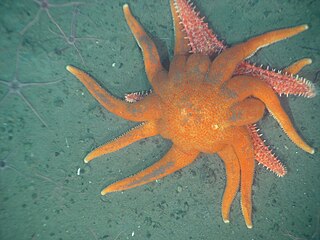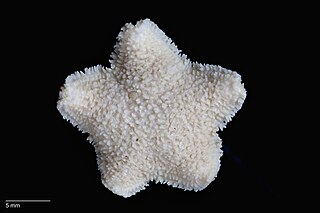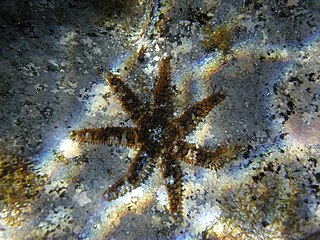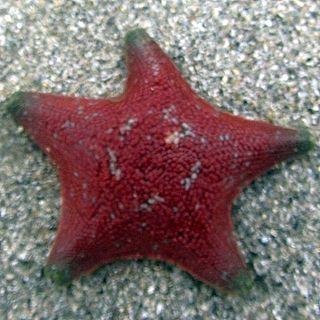
Starfish or sea stars are star-shaped echinoderms belonging to the class Asteroidea. Common usage frequently finds these names being also applied to ophiuroids, which are correctly referred to as brittle stars or basket stars. Starfish are also known as asteroids due to being in the class Asteroidea. About 1,900 species of starfish live on the seabed in all the world's oceans, from warm, tropical zones to frigid, polar regions. They are found from the intertidal zone down to abyssal depths, at 6,000 m (20,000 ft) below the surface.

The Valvatida are an order of starfish in the class Asteroidea, which contains 695 species in 172 genera in 17 families.

The Asterinidae are a large family of sea stars in the order Valvatida.

Patiriella is a genus of sea stars of the family Asterinidae. Many species formerly included in this genus have been transferred to other genera. They are commonly known as carpet sea stars.

Patiriella regularis, or New Zealand common cushion star, is a sea star of the family Asterinidae, native to New Zealand. It has an arm spread of up to 60 mm (2.4 in).

Parvulastra exigua, or the dwarf cushion star is a species of sea star in the family Asterinidae. It can be found in temperate intertidal marine communities from geographically widespread sites around the southern hemisphere.
Meridiastra gunnii is an Australian species of sea star.

Meridiastra mortenseni is a sea star of the family Asterinidae. It is endemic to New Zealand. Described as Patiriella mortenseni in 2002, it is named after T. Mortensen, who recorded it as distinct from Patiriella regularis, the New Zealand common cushion star, in 1925. According to genetic evidence, P. mortenseni was moved from the Patiriella genus to Meridiastra in 2004.

Patiria miniata, the bat star, sea bat, webbed star, or broad-disk star, is a species of sea star in the family Asterinidae. It typically has five arms, with the center disk of the animal being much wider than the stubby arms are in length. Although the bat star usually has five arms, it sometimes has as many as nine. Bat stars occur in many colors, including green, purple, red, orange, yellow and brown, either mottled or solid. The bat star gets its name from the webbing between its arms, which is said to resemble a bat's wings.

Asexual reproduction in starfish takes place by fission or through autotomy of arms. In fission, the central disc breaks into two pieces and each portion then regenerates the missing parts. In autotomy, an arm is shed with part of the central disc attached, which continues to live independently as a "comet", eventually growing a new set of arms. Fragmentation occurs on star fishes.

Pteraster tesselatus, the slime star or cushion star, is a species of starfish in the family Pterasteridae found in the North Pacific.

The orange knobby star, Echinaster echinophorus, is a species of sea star found in the Caribbean Sea and along the Atlantic coast of South America.
Parvulastra parvivipara is a very small species of starfish in the family Asterinidae. It is a viviparous species and gives birth to live young. It lives in rock pools on intertidal granite rocks in a limited area of South Australia.

Marthasterias is a genus of starfish in the family Asteriidae. Both species in the genus are commonly known as the spiny starfish.

Patiria chilensis is a species of starfish in the family Asterinidae. It is found in the southeastern Pacific Ocean along the coasts of South America. It is a broadly pentagonal, cushion-like starfish with five short arms.

Heliaster helianthus, the sun star, is a species of Asteroidea (starfish) in the family Heliasteridae. It is found in shallow water rocky habitats and in the kelp forests off the Pacific coast of Ecuador, Peru and Chile.

Starfish, or sea stars, are radially symmetrical, star-shaped organisms of the phylum Echinodermata and the class Asteroidea. Aside from their distinguishing shape, starfish are most recognized for their remarkable ability to regenerate, or regrow, arms and, in some cases, entire bodies. While most species require the central body to be intact in order to regenerate arms, a few tropical species can grow an entirely new starfish from just a portion of a severed limb. Starfish regeneration across species follows a common three-phase model and can take up to a year or longer to complete. Though regeneration is used to recover limbs eaten or removed by predators, starfish are also capable of autotomizing and regenerating limbs to evade predators and reproduce.

Parvulastra is a genus of starfish belonging to the family Asterinidae. The species of this genus are found in Southern Hemisphere.

Meridiastra is a genus of star fish in the family Asterinidae. The genus is found in the Indian and Pacific Oceans, with most records from the waters around Australia. They occur in shallow waters down to a depth of about 59 m (194 ft). Meridiastra are morphologically similar to the Atlantic genus Asterina. They are also phylogenetically close and possibly sister genera.


















